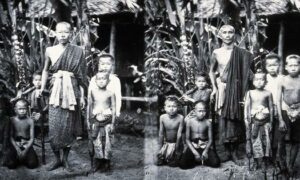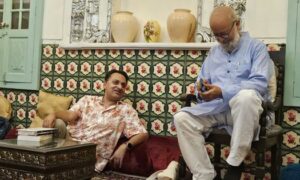
“They would make the Mangs and Mahars drink oil mixed with red lead and bury our people in the foundations of their buildings, thus wiping out generation after generation of our poor people. The Brahmans have degraded us so low; they consider people like us even lower than cows and buffaloes.”
— Muktabai Salve, About the Grief of the Mangs and Mahars (translated from Marathi)
In 1855, a young Dalit girl wrote these words, exposing a society structured by caste violence – quite literally on the burial of Dalit bodies. More than a century later, Sindhu Rajasekaran’s Forbidden Desire: How the British Stole India’s Queer Pasts seeks to recover India’s lost queer histories. Yet in its attempt to decolonise, it overlooks the caste histories that structured the material realities of people in both the past and the present.
At the outset, the book is a remarkable project, venturing into areas that Indian writing sometimes hesitates to touch: gender, sexuality, intimacy, and the myths that tie them together through colonial histories. The book raises an important and timely question: how did colonialism shape the way we think about desire and intimacy? Simply raising that question is an achievement in itself.
Beyond its central thesis, the book offers several strengths. It opens up a conversation about sex and sexuality in India with a clarity and warmth that makes a potentially daunting topic accessible. It brings together a wealth of material ranging from colonial archives to the lives of devadasis, courtesans, commoners, medical and legal records, and newspaper reports, creating a rich repository for anyone interested in the history of sexuality. And Rajasekaran’s approachable, conversational style makes the reader feel as though they are sharing a private, thoughtful dialogue with the author herself.
With a stunning cover in deep pink and dark orange, depicting what looks like two courtesans lying beside one another, the book positions itself as an intervention in India’s cultural memory. Its central claim, printed even on the flap, is clear: “Before the British colonised the Indian subcontinent, it was largely protofeminist and queer.” Across fourteen chapters, Rajasekaran attempts to substantiate this thesis, asking: What did sexuality look like in premodern India? To answer this expansive question, she presents an analysis of value systems, British moral codes, policies, and practices to address the erasure of desire and queerness from Indian historiography.
The book repeatedly asserts that British colonialism is the primary cause of India’s erased queer histories. While this holds some truth, it neglects a crucial fact that long before the British arrived, desire and intimacies in India were already structured by caste. Forbidden Desire rarely considers this. Its decolonial ambition is incomplete because it speaks of oppression without fully grappling with the social fabric that made that oppression possible.
Absence and erasure of caste
It is not that the book ignores caste – it does mention it. The problem lies in how it is addressed. Rajasekaran treats caste as a cultural difference rather than as a violent social order governing access, desire, and intimacy. In her telling, caste becomes a marker of diversity rather than a structure of punishment, exclusion, and death.
Forbidden Desire presents precolonial India as a socially diverse space where people of all genders and sexual orientations across castes intermingled and shared intimate lives, suggesting, for instance, that Dalits were part of an educated “middle class” enjoying proximity to the British with inadequate evidence. With the publication of Merchants of Virtue, all of this changes. In this book, historian Divya Cherian throws open precolonial archives to examine the governance of caste, untouchability, and “virtue” alongside the coalescence of a Hindu political community in the early modern Rajput kingdom of Marwar. The evidence considered is voluminous: half a century of petitions received and orders issued by the Marwar crown in the reign of Vijai Singh (1752–1793) and Bhim Singh (1793–1803), composed in Old Marwari and inscribed in bahīs (ledgers) preserved in royal chanceries. Cherian’s methodical analysis of this archive delivers findings that are, by any measure, astonishing. Not only did this precolonial kingdom enforce untouchability and define Hindus with some precision – there’s nothing nebulous about the social distinctions upheld by this state – but it also, as part of the same overarching Vaishnava ethical project embraced by Vijai Singh and his merchant-dominated bureaucracy, banned abortion, prohibited alcohol, criminalised meat-eating, dispossessed Muslims of livestock, and expelled entire nomadic castes from its territory. Rajasekaran’s claims flatten difference, erase long histories of exclusion, and present precolonial India as a space of free social mingling, ignoring centuries of caste-based violence.
Muktabai Salve’s searing essay reminds us that caste was never merely about difference – it was about annihilation. Dalits were punished or even killed for entering upper-caste spaces. How could there have been intimacy or free mixing? Desire in India has always been mediated by caste – who one could eat with, touch, love, or marry. Such acts were never power-neutral; they carried the full weight of hierarchy.
Rajasekaran cites Shashi Tharoor to describe caste as “a broadly mobile form of social organisation constantly shaped and reinvented by the beliefs, politics, and economic interests of dominant men of the times.” Caste has never been mobile. Dr BR Ambedkar described the caste system as “a tower without a staircase.” Were caste flexible or evolving, basic human dignity would not still be a luxury in India.
Neither caste nor intimacy is power-neutral. A society that denied people the right to draw water from the same well could not have permitted social or sexual equality, and in Salve’s own words, treated them even lower than cows and buffaloes”. Works such as The High-Caste Hindu Woman by Pandita Ramabai and Ants Among Elephants: An Untouchable Family and the Making of Modern India by Sujatha Gidla reveal how gender and caste together shaped the possibilities of intimacy long before colonialism.
Rajasekaran draws on primary colonial archives and texts like the Vedas, Puranas, Gita, and Kamasutra, repeatedly noting when these texts are casteist or exclusionary. She invokes Hindu gods and rituals to discuss gender fluidity and argue that Hindu rituals were not strictly procreation-centric. But her treatment remains depoliticised. The women she foregrounds are almost entirely Savarna, yet their experiences stand in for “Indian womanhood.” She homogenises women across all socioeconomic backgrounds and presents them as a diverse power neutral group. While framed as evidence of fluid or queer-friendly social structures, these examples are grounded in Brahminical authority and rarely account for caste-based exclusions. Even when she critiques texts like the Kamasutra as casteist, she still relies on them to frame her understanding of queerness, reinforcing Brahminical epistemes that excluded Dalit–Bahujan bodies from discourses of pleasure. Similarly, citing figures like Devdutt Pattanaik, known for casteist slurs and sexist perspectives, undermines the book’s claim to feminism or anticaste analysis.
By treating caste as a non-entity, Forbidden Desire raises a crucial question: whose voices and whose desires are being centred in this history? The text spans lives from commoners across all genders and sexual spectrums to kings and queens to courtesans and devadasis across ancient and medieval India, appearing on the surface to map India’s sexual history while attending to its socioeconomic fabric. But without acknowledging the material reality of oppressed groups.
If the sources systematically exclude Dalit, Bahujan, and Adivasi people, whose history is this? Can texts representing only Savarna perspectives count as “indigenous knowledge”? Where are the myths, oral histories, and literary traditions of Dalit and tribal communities? Jotiba Phule’s Ghulamgiri is notably absent. What emerges, then, is not a decolonial recovery but a Savarna reimagining of queerness, glossing over the ongoing violence of caste in shaping desire, intimacy, and access.
A homogenised sisterhood
From the outset, Forbidden Desire uses terms like “Indian womxn,” “native mxn and womxn,” and “brown people” to refer to people of all genders. The book claims that in precolonial India, “womxn” and “mxn” were collectively sexually liberal, freely choosing partners and engaging in liaisons with one another and even the British.
The choice to use terms like “womxn” “mxn” carries limitations. It excludes trans women and induces discomfort in non-binary readers. As it is not a self-chosen term and carries the same burden that harijan vs Dalit carries for oppressed castes.
Hypersexualisation of oppressed-caste women is particularly striking. Rajasekaran writes:
“While women in the zenanas wore opaque saris that showed off their figures, most working-class womxn wore no blouses. They drove the British properly mad. Every Indian womxn was a sexual siren, it seemed.”
This erases histories of oppression, ignoring crucial women like Nangeli, who chose to chop off her breast rather than pay the upper-caste breast tax. How can a lack of blouses be framed as agency when oppressed-caste bodies were surveilled and controlled through such practices for centuries?
The homogenisation of “brown women” also masks deep-seated caste hierarchies. Varna literally means colour. Dalit women have historically been stereotyped as dark skinned, promiscuous, loud, and undesirable, while Savarna women are associated with purity, fair skin, and Brahminical beauty standards. Rajasekaran’s claim that all Indian women were “sexual sirens” erases these caste realities. Colourism in India is intertwined with caste, reinforcing exclusion and hierarchy.
Similarly, Rajasekaran attributes oppressive norms when it comes to India to individuals– “Puritanical Brahmins”, “Bhadralok types” “, puritanical madhatter clubs” as isolated one-off groups – rather than acknowledging Brahminical patriarchy as systemic and its larger implications for Indian society.. In India, the default social and cultural norm is the Hindu cis-het Savarna man. Deviations from this norm – through caste, gender, sexuality, or religion – bring deprivation in access, agency, and mobility.
Desire and intimacy cannot be understood without attending to caste-based power, which shapes access, consent, and bodily autonomy. A truly decolonial recovery of queer history must account for caste, gender, sexuality, and material realities together. Forbidden Desire, despite its ambitions, fails to do so.
It is often asserted that the British used divide-and-rule to pit Indians against one another. Yet the solution does not lie in noting India was already divided, hierarchical, and dehumanising. Acknowledging difference through curiosity and parity is the first step toward addressing structural inequalities. Glossing over caste, generalising experiences, or framing precolonial India as an almost sexual utopia does not help. India has always been socially, politically, and economically complex, with these dimensions shaping who has access, voice, and power. And who enters the paperwork and documentation.
The realities of India today are not solely the result of British colonialism; they are also the product of a caste system that has persisted for thousands of years. Colonialism compounded the oppression of already marginalised groups. To understand India under the Raj, we must ask: for whom was it dystopian? For Dalits, Bahujans, and tribal communities, India was already a space of systemic violence, denial of basic human rights, and restricted access to resources.
A truly decolonial recovery of India’s queer past must confront caste, gender, sexuality, and material conditions together. Desire and intimacy cannot be divorced from power, access, and hierarchy. Dr BR Ambedkar, in Castes in India: Their Mechanism, Genesis and Development, demonstrated that caste and gender flow from the same source; they are not separate. To recover India’s queer histories responsibly, we must recognise that oppression and privilege operate simultaneously along multiple axes.
Kamna Singh is a researcher whose work centres on life writings by Dalit women and the historiography of Dalit women’s movements in India.
Forbidden Desire: How the British Stole India’s Queer Pasts and Queer Futures, Sindhu Rajasekaran, Simon and Schuster India.
📰 Crime Today News is proudly sponsored by DRYFRUIT & CO – A Brand by eFabby Global LLC
Design & Developed by Yes Mom Hosting






